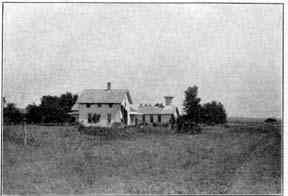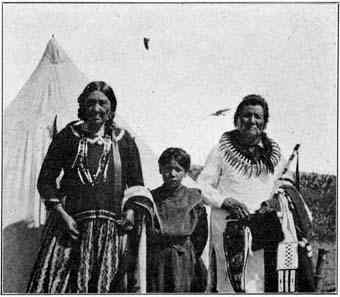|
22
|
SEMI-CENTENNIAL HISTORY OF
NEBRASKA
|
|
reservation on the Big Blue river in Gage
county. This in turn was demanded by the white man and in
1881 it was sold and the tribe went south to its present
home in Oklahoma.
The story of the Ponca
tribe is one of the most interesting and romantic in
Indian annals. The little tribe, numbering something over
a thousand was found by the earliest white explorers
occupying the country at the mouth of the Niobrara river.
During the whole of the eighteenth and three-fourths of
the nineteenth centuries this was the most exposed
outpost against the wild Indians of the northwest, the
fierce Oglala and Brule Sioux, who, although the blood
kindred of the Ponca, were their bitterest enemies. In
spite of losses by this ceaseless border warfare, and by
smallpox, the little band maintained itself in its
ancient home and remained from the first the firm friend
of the whites. When the great Sioux treaty of 1868 was
made at Ft. Laramie by some blunder that no one has ever
explained, the whole Ponca reservation, which had been
guaranteed to the tribe over and over again in repeated
treaties by the national government was given to their
deadly enemies, the Brule and Oglala Sioux. Soon as their
enemies understood that the Ponca territory had been
given to them by treaty of the United States their raids
became more fierce and frequent. The seven years that
followed the Ft. Laramie treaty were years when the
Poncas were obliged to work their little gardens and
cornfields as did the Pilgrims in New England or the
early settlers of Kentucky, with hoe in one hand and
rifle in the other. In 1876 congress passed an act
providing for the removal of the Poncas to Indian
Territory, with their consent. The next year another act
was passed for their removal to the territory without
regard to their consent. In the spring of 1877 the Poncas
were busy putting in their crops. Many

Ponca Indian Agency and School August 19, 1904.
had sown spring wheat. Some had put in corn and
were engaged in gardening. A force of soldiers arrived
and orders were sent out for all the Indians to prepare
to move at once to Indian Territory. There were
heart-breaking scenes in the little tribe. The Niobrara
and Ponca valleys had been their home so long they knew
no other. The graves of a dozen generations were there.
The little fields their foremothers had cultivated with
buffalo-bone hoes before the white trader brought in iron
tools were to be abandoned. There were tears in the
teepees and hot words in the little councils. The cooler
heads prevented an outbreak and the long march to the
south was begun. Arrived at their new home the warm,
moist climate, so different from the dry, bracing air of
their Nebraska home, brought on sickness. Out of seven
hundred and ten, one hundred and fifty-eight died the
first year. Homesickness, worst of all diseases in misery
that it carries, was in every lodge.
In the
mid-winter of such a scene of wretchedness, Chief
Standing Bear, with a little band of thirty relatives and
retainer's,
|





